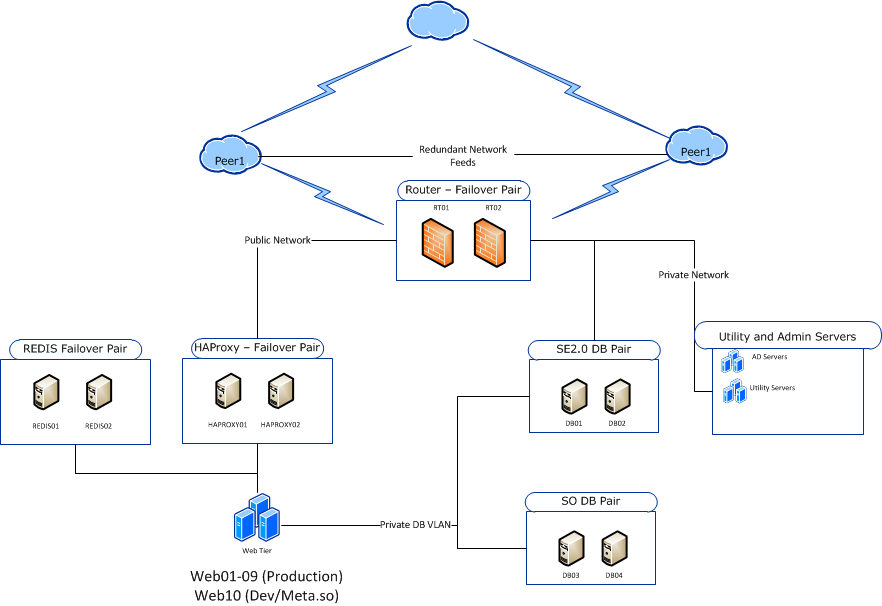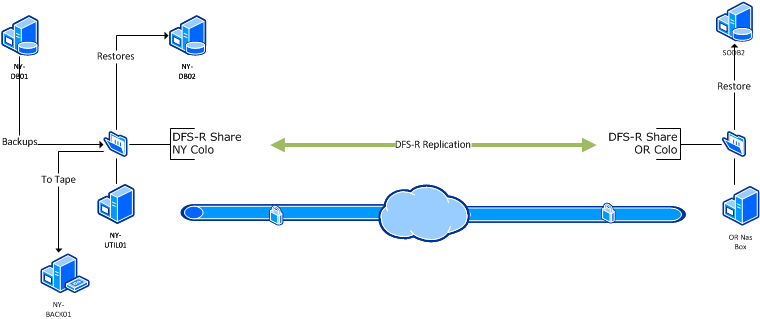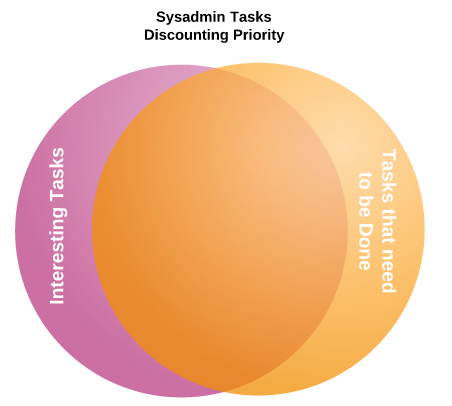My Thoughts on Production Control
Peter Grace
One website defines production control as the following:
Activities involved in handling materials, parts, assemblies, and subassemblies, from their raw or initial stage to the finished product stage in an organized and efficient manner. It may also include activities such as planning, scheduling,routing, dispatching, storage, etc.
That definition is a fairly broad one, but can easily be applied to Information Technology when one is tasked with making sure a software or service that your consumers rely on remains responsive and available at all times.
Simply put, production control is establishing processes/checklists that help you and your fellow team members ensure that you do the right tasks, in the right order, every single time. What does this solve for? Firstly, production control assists in mitigating lost revenue by preventing unexpected downtimes. If you have a process where you catch most mistakes early, users will not be burdened with being your QA department. You also save the users from dealing with longer “we’re having trouble reverting something that we accidentally broke” downtimes.
Production control also encourages developers to be more cognizant of bugs/errors before the consumer finds them. If there’s an organized line-of-custody to a release, then it is easy to identify where a link in the chain fails. This is not to say that someone should be disciplined or chastised for mistakes! We’re all human, it happens. It does, however, help point towards where some extra assistance could be lent in the process to make sure things go smoothly.
As a corollary, production control does help break the “circle of blame” that can occur in organizations when a problem is found. If there are signoffs in the process, then glaringly obvious issues that aren’t detected can be tracked back to someone not properly executing the checklist. Again, this does not need to result in disciplinary action, it just further helps indicate where more manpower or alternative practices could help shore up the defenses.
An implicit benefit of production control is that it eliminates the “too many cooks in the kitchen” syndrome. If all of your developers have access to change production, you can run into situations where two people may not communicate that they’re fixing the same issue and unwittingly cause each other serious delays as they attempt to fix the problem. If you’ve ever heard “I swore I just changed that line of code!”, there’s a good chance that person did. Except, someone else changed it back when they uploaded the file with a different change.
For organizations that do not use production control methodology, there are some hurdles to adoption. If one looks at the situation from the top-down, obviously executive buy-in can be problematic. Small businesses generally have owners who are used to having complete and total control over everything in their organization, and in tech companies this generally means they want to be able to change whatever they want (even production), whenever they want (when they feel like something should be tweaked at 3am) and you’re expected to deal with that. This method of thinking is extremely disruptive to technologists that generally like things to run in smooth, planned ways. However, if you effectively present your argument, executives will generally buy-in on the idea. Worded properly, they will accept that the process, while seeming like unnecessary fluff that “only big companies need to do”, will actually make their product better and as a result bring in more revenue.
Are the benefits worth the pains? Not only do you need to convince the executives, but also the developers. This can be difficult if you have a development team full of “beautiful and unique snowflakes.” In my experience, however, developers have been more supportive of production control. I’ll admit that I had not considered the “circle of blame” breakage as a benefit until a developer mentioned it to me, once upon a time. His consideration was sound: “The less access I have to production, the less chance someone is going to say ‘You broke production while fiddling around on the server.’”
The exercise now is to define a sane production control methodology, and this varies wildly based on how important bugcatching is for your organization. The most basic form of production control is when you have developers promote their code to a staging server which mirrors production as closely as possible. Then, the developers can test their new changes at that server, prior to tossing notice over to the operations team to have them push the code to production. This method has a single handoff, and is best in lower-impact, low-opportunity-cost-of-downtime shops. The process can get more involved if you have people willing/able to do QA in a dedicated role. This can be helpful for developers, since developers often fall into the trap of “testing like the guy who developed it” rather than “testing like the user consuming it.” In this case, the developer would stage and hand off to QA, then QA would test and upon approval, toss it over to operations for the push. If you’re a fan of flowcharts, this type of procedure is a flowchart designer’s wet dream. There’s no limit to how bogged down this can get, but remember: If the process is cumbersome, people will not want to follow it.
Whether you choose to implement a process such as the one presented, or continue to move forward without it, remember that in all things, there are benefits and detriments, but by and large these processes exist because they work and eliminate unknowns from the equation. Dear readers, what are your thoughts on this topic?
Welcome Server Fault Valued Associate #000003
George Beech
We have gone and done it, we’ve expanded our Systems Administration team to THREE people. I’d like to introduce you to Peter Grace who we have just brought on board as our third sysadmin.
This is the second company I’ve had the honor of working with Pete at, and I can say that he is an exemplary System Administrator. In addition to being a great sysadmin, Pete is a fellow gun enthusiast, which increases our zombie attack survival rate by 35%.
Pete and I have done many great things together in the past, and I’m very excited about what he brings to us and the great things he, Kyle and myself are going to do as we move forward doing our part to make the internet better.
Technology, not Products
Kyle Brandt
I have always had the notion that some companies “Get It” when marketing to programmers, sysadmins, and hackers. A couple weeks ago I was in Silicon Valley at Tech Field Day listening to a lot of presentations with some fellow geeks. In some of these presentations they “got it”, in others they didn’t.
The fundamental difference is that the ones that get it tell me about their technology, and the ones that don’t tell me about their products. True geeks have one common trait, and that is that they like to learn how things work. We get excited about learning and news ideas. Exciting technologies solve problems in non-obvious ways. Since these are not obvious, we want to learn about them, and in as much detail as possible.
Products, on the other hand, are how these ideas are packaged. For the most part, we don’t care. If we do care, that comes later, only if it will solve a problem that we have will we start to care about implementation and packaging. The advantage of telling us about your technology is that we do care, even if we don’t have a use for it at the moment, because we are geeks – it is our nature. When done right, we will then associate your product with the technology and that will be enough.
This has some consequences that marketing should be aware of when targeting tech people. First, we generally don’t want to talk to you directly, at least, not for very long. This is not because you are not important or interesting, it is just that you probably can’t get us excited about your technology like your engineers can. You can enable your engineers to present your technology well, and that is what people who are good at geek marketing do. If you can’t get your actual engineers to present no mater how hard you try, your screwed. It’s not your fault, your company just sucks and you probably just need to move on. Lastly, everything targeted to tech people should be aimed at getting us excited about your technology, not your product.
With my recent experiences at tech field day there were some good examples of this done right. Pure Storage taught me about why I see SSDs fail and a new type of RAID they invented suited for SSDs. Arkeia educated me about various implementations of deduplication in backups. Data Direct Networks introduced me to the concept of object store filesystems. However, in that case I wanted to learn even more given that amount of time. How successful they were came down to how much time they all devoted to fulfilling my desire to learn more about technology vs. telling me about their products.
I’ve recently been looking back on what we have written about our architecture in the past, and came to a stunning realization. That realization is that while we have many many different articles about what we have been doing there hasn’t been a good, solid overview of our architecture in a long time. In fact, the last really comprehensive write-up was done by Jeff before this blog even existed. And, boy I do have to say there has been quite a lot of change behind the scenes since then. So, my dear readers I’m going to take some time – and my next few blog posts – to give everyone an in depth look into how we have the Stack Exchange Network setup to serve between 12 and 14 Million page views per day.
How these posts will breakdown
Since we have obviously grown, and are offering more services to our users I’m going to break these posts out by each of the 4 major services we offer to our user base:
- Core Q&A (this includes the API)
- Careers
- Chat
- Community Blogs
Each one of these systems all work towards our goal of making the internet better, but they have different requirements and different challenges.
In this first post, I’ll be focusing on our core Q&A system, since that is after all our bread and butter.
Core Q&A
First, a high level overview of how everything is put together:
The Hardware
Our core hardware setup hasn’t changed all that much. Well, I should say the chassis haven’t changed that much. We’ve done a lot of work to upgrade the internals of the servers when needed to address performance issues as they came up, as well as handle issues that resulted from Stack Overflow being so big.
Web Tier
Of these 10 Servers, 3 are dedicated to Stack Overflow with an additional 3 servers serving Stack Overflow and the Stack Exchange Network. We have one server dedicated to Dev/QA – which also hosts meta.stackoverflow.com. Our Web Tier machines normally operate between 5 and 20% utilization. We have plenty of room to grow on these boxes.
- 10 Dell R610 IIS web servers:
- 2x Intel Xeon Processor E5640 @ 2.66 GHz Quad Core with 8 threads
- 16 GB RAM
- Windows Server 2008 R2
- 2 drives
- RAID 1
- 2x Intel 320 300GB SSD (RAID 1)
DB Tier
We have two database server pairs. One pair is dedicated to running Stack Overflow, and the other runs the rest of the network. We run development against the secondary server of the non-stack overflow database pair. Both of our database pairs run at about 20% utilization, so once again we have room to grow here as well.
- 2 Dell R710 database servers:
- 2x Intel Xeon Processor X5680 @ 3.33 GHz
- 96 GB RAM
- 8 spindles
- Mirrored Pair for OS
- 6 disk RAID10 for databases
- SQL Server 2008 R2 SP1
- 2 Dell R710 database servers (Stack Overflow Dedicated):
- 2x Intel Xeon Processor X5680 @ 3.33 GHz
- 96 GB RAM
- 8 drives
- Mirrored Pair for OS
- 6 drive RAID10 of Intel X25-E SSDs for Database
- SQL Server 2008 R2 SP1
Caching Tier
We run redundant Redis servers for our caching tier.
- 2 Dell R610 Redis servers:
- 2x Intel Xeon Processor E5640 @ 2.66 GHz
- 16 GB RAM
- CentOS
Network Layer
We use HAProxy for our load balancing, and Cisco Switching.
- 2 Dell R610 HAProxy servers:
- 1x Intel Xeon Processor E5640 @ 2.66 GHz
- 4 GB RAM
- Ubuntu Server
- 6 WS-C2960S-48TS-L Gigabit switches
- FlexStack (two stacks, 4 switches and 2 switches)
Data Integrity
As with any system, making sure that your data is backed up and the backups are good is an integral part to your service offering. We backup our databases nightly and restore them to two different locations. One local to our NY data center for our devs to work against, and one remote in our OR data center.
Conclusion
Overall I believe that we are in a good place and have plenty of room to grow given our current setup. As always we will constantly be looking at our infrastructure and tweaking it to get the best performance possible and give our users the best experience possible.
The END of the WORLD is NIGH
Kyle Brandt
System administrators can sometimes seem like they are trying to get everyone down. Someone goes to them with a great idea, application, feature, or just something they just want to get done. When the sysadmin comes in, instead of being enthusiastic about the great idea, he starts talking about viruses, hacking, earthquakes, floods, fires, Vogon invasions, and all the things that can go wrong. Because of this, the natural reaction is to stick the sysadmin in the basement and stop inviting them to parties.
In order to work past this issue, it takes a little work from both sides of the table. Coworkers need to remember that disaster is part of a sysadmin’s job and that Murphy’s law is part of what they do. Part of a sysadmin’s job to think about this stuff all the time because we are expected to have backups and to be able to recover from small events to major disasters. Major disasters are uncommon but do happen, hence the importance of offsite backups at a minimum. Small disasters, such as power failures, router failures are actually quite common. When a sysadmin is doing a really good job, people don’t even know about some of the smaller failures.
It also falls on the sysadmin’s shoulders not get stuck in this gloom and doom world. We have remind ourselves not to get in the habit of saying No to everything because something could go wrong. This is important because the danger is that that people will try to start bypassing you or just not believing you when you talk about very real threats because they think you are crying wolf. It largely comes down to being mindful of the bad things that can happen while being enthusiastic about all the good things that can come from a new idea or feature.
It can be tough not be the guy in the street with the end of the world sign when in a way it is part of your job, but learning how to find the balance is one of the challenges of being a sysadmin.
Eating Our Vegetables
Kyle Brandt
Our CEO Joel Spolsky wrote a book about hiring programmers that is titled Smart & Gets Things Done. The idea behind the title is that when it comes down to it, you really just want to hire someone who is both smart and will get things done:
“People who are smart, but don’t get things done … would rather mull over something academic about a problem than ship on time”.
This applies equally in the area of system administration. Our CTO Jeff Atwood recently tweeted a reference to this:
When I read that I felt like he was talking to the sysadmin team (I hope he wasn’t — but the fact that I felt like he might have been is enough). The reason for this isn’t that we are not getting things done; I think we work hard and get a lot of things done. Rather, I think we have tendency to pick the interesting tasks over the uninteresting or tedious tasks.
Assuming as a system administrator you actually like what you do, I think tasks end up looking like the following:
So there are some interesting tasks that would be good to do, but may not need to be done. Then you have most tasks, which if you like your job, both need to be done and are interesting. Lastly, you have the tasks that are not interesting but do need to be done.
With a tendency to give too much weight to the interesting tasks or pieces of a project, that category on the right will grow over time. I like to think of keeping that category under control as eating my vegetables. Ideally, one maintains a good balanced diet all the time. But in reality there are times when you need to get on the scale and come to grips with the fact that you might need to go on a healthy diet for a while.
Lastly, don’t worry, the irony of taking some time to write this post is not lost on me.
Stack Exchange Maintenance This Saturday
Kyle Brandt
This Saturday, August 6th starting at 3pm EDT (19:00 UTC) we will be taking our sites offline for maintenance. We are aiming to keep the downtime to about one to four hours. Should we need to extend this window I will post updates on this post.
During this window we are going to be patching our database servers. We are also migrating our servers to a new AD domain so we have everything under a consistent naming structure.
We Have an Alerting Problem
Kyle Brandt
Hello, our name is Stack Exchange and we have an alerting problem. It hurts us, our friends, and our family. We are not sure how we got here. Sure, we get some extraneous alerts, but everyone does right? Then one day we woke up and had an inbox full of alerts. We wrote it off. We told ourselves that it happens to everyone. But then it happened again, and then again. We don’t want this. We don’t want to live like this anymore. We are ready to pick ourselves up. We are ready to face this problem and live a new, and better life.
Don’t know if you have a problem? Here are some of the signs:
- You get alerts that you just don’t care about, because of this you maybe don’t see the ones you do care about.
- The more serious ones wake us up in the middle of the night when they don’t need to because someone else is already dealing with them.
- When something major happens your inbox is flooded.
- You set up email rules to handle them.
- You are ashamed.
If like us, you have an alerting problem and you have admitted it, I believe finding the righteous path starts with one rule:
Every Alert Requires Action
Every alert requires action. The problem we have right now at Stack Exchange is that alerts don’t require that we do anything. If we are to address our alerting problem — I believe this, more than anything, needs to be fixed. When I mean every alert, I do mean every alert. So what sort of actions can we take:
- If it is real problem and you are dealing with it — acknowledge the alert.
- If it is a false alert, acknowledge and adjust the threshold level
- If the alert was a flood of alerts, acknowledge them and set up dependencies.
In order to do this we need a few things. We need a system that allows to effectively acknowledge alerts without too much friction. We need cooperation from everyone to use this system once it is in place. Lastly, we need to accept that we don’t have the power to cure our alerting problem. We can, however, through constant vigilance, get it under control.
Making Devs Happy With Hardware
George Beech
Recently there was a question on the Programmers site asking “Why don’t all companies buy developers the best hardware?” This is actually a very interesting question and there was a good deal of discourse on the topic, as there always is when you get a group of professionals talking about the tools of their trade.
We here at Stack Exchange pride ourselves on not letting the technology get in the way of our devs. We want them to be able to do their job – which is writing code, and doing it well – with minimal hassle. Now, I have to take a brief moment to make a little bit of a note some of the things we do do not scale.
The philosophy that is maintained when getting a developer a new machine is a pretty simple one:
> If a dev is constantly struggling with their machine they aren’t getting work done, they aren’t happy, and they are producing bad code. All of these things are more expensive than a nice developer machine
As a sysadmin – and hence the guy in charge of getting the devs what they need you find out really quickly that they know what they want for the most part, and for those that you don’t ask if you give them a powerful machine with a lot of screen real estate they are generally very happy.
Since I mentioned earlier that there are some things we do here that aren’t all that scalable – in that they work for a company with 20 devs but not 100 i’ll split them up.
The Scalable
The base config that I get new devs in the NY office is:
- Dell Optiplex 980 class tower
- Max out the RAM
- Best i7 Processor that I can get in it
- SSD primary drive
- 7.2k large (500GB – 1TB) Secondary Drive
- 30″ Primary Monitor
- 20″ Secondary monitor (turned sideways)
Every dev picks their own keyboard – we may give them the crappy one that comes with the machine to get them up and running, but they can request any keyboard/mouse combo they want (and … i do mean any).
The not so scalable
- For our remote devs we get workstation replacement class laptops. Basically I go out and find the most powerful laptop I can get at the time they start, as well as a 30″ monitor to go with it. Not Scalable.
- At least one dev in the NY office has a fully customized hand built machine with 2 30″ monitors. VERY not scalable.
- Whatever they want – within reason
Basically, it boils down to get them what they need to get their job done. One of the biggest challenge to some people is that they do not have management’s buy-in to get the Devs what they need. I find that this is a sad state of affairs, but I have no real advice to offer – especially since I work somewhere that management has mandated great dev machines.
A Non-Foolish Consistency
Kyle Brandt
 In the never ending quest for better performance and response time, perhaps consistency is underrated. In web operations the desire is to make page loads go fast, because performance is a feature, or more simply — people like responsive web pages.
In the never ending quest for better performance and response time, perhaps consistency is underrated. In web operations the desire is to make page loads go fast, because performance is a feature, or more simply — people like responsive web pages.
Probably the most common and simplest way to look at response time is to look at the average response time for the primary web request in a page load. Page loads also need to be looked at from the perspective of how they render in a browser (Which is how Google looks at it). This all makes sense, but as you push your load times faster and faster, the savings start to get smaller and smaller. For instance you start reducing the average time of certain requests from something like 1 second to 500 MS, then 500 to 100, then 100 to 80, 50, 30, 15, 10. Eventually these push to limits where you are less likely to feel the difference. It doesn’t mean it is time to stop, but I think in general it makes sense to shift your attention elsewhere for performance gains.
When this happens, a next logical step is often to go for a Content Delivery Network. The CDN can help reduce load times for people who are geographically far from the main servers. We did this back in May for our static content. Then what?
I think a next logical step is to start to shift attention to the consistency of your web server’s response time. By consistency I mean addressing those responses that take a lot longer than your average request time because of the server’s response time. In other words, fixing the outliers. To address these, is quite frankly, a pain. Why?
- You need a decent sized sample of the response time of every request
- At hundreds of requests a second, it is hard to pin down the cause of these outliers. It can be code, DB behavior, network blips, etc.
The best way I have come up with to measure this is to pull the response time from our web logs as our load balancer measures it from:
Server response time (HTTP mode only). It’s the time elapsed between the moment the TCP connection was established to the server and the moment the server sent its complete response headers. It purely shows its request processing time, without the network overhead due to the data transmission…
To be honest, I am not sure if this is the best way, but it seems like a reasonable start. I then filtered a sample of log requests so that I was only looking at authenticated users loading a question on stackoverflow.com that got a 200 response code from the web server (to ease in taking crawlers out of the mix). Then to express the outliers I used a box-and-whisker plot. If you have been wondering just what that image on the right is — this is what you are looking at. You can go read more about it, but in short, the dots are the outliers. When you look at this as a histogram these outliers will be the long tail (which in this case pushes the average to the right of the median).
I have been giving Marc Gravell some data and we were able to pin down a lot of these as collateral damage to a particularly demanding background thread that runs on each server. He is reworking this to help eliminate a lot of these.
I think keeping an eye on these outliers or the long tail of response is going to be tricky, but I also think it plays an important role in the quest for better performance.






